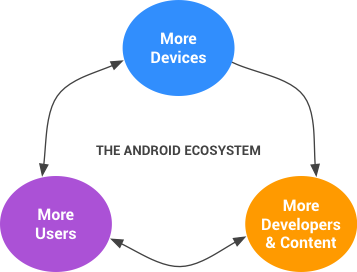Android 호환 기기란 Android SDK 및 NDK를 사용하여 서드 파티 개발자가 작성한 서드 파티 앱을 실행할 수 있는 기기입니다. Android 호환 기기는 호환성 정의 문서(CDD)의 요구사항 목록을 준수하고 호환성 테스트 모음(CTS)을 통과해야 합니다. Android 호환 기기는 Android 생태계에 참여할 수 있습니다. 여기에는 Android Play 스토어 및 Google 모바일 서비스(GMS) 애플리케이션 모음 관련 잠재적 면허 보유와 Android 상표 사용이 포함됩니다. 누구나 Android 소스 코드를 사용할 수 있으나 Android 생태계의 일원으로 인정받기 위해서는 기기가 Android 호환 기기여야 합니다.
이 문서에서는 Android 호환 기기인지 확인하기 위한 절차, 요구사항, 테스트를 의미하는 Android 호환성 프로그램에 관해 개략적으로 설명합니다.
호환되는 Android 기기를 빌드해야 하는 이유
사용자는 맞춤설정 가능한 기기를 원함

그림 1. 기기 호환성을 갖춘 Android 생태계
휴대전화는 매우 개인적이고 항상 사용하며 늘 곁에 두는 인터넷 접속 게이트웨이라고 할 수 있습니다. 지금까지 기능을 확장하여 맞춤설정하지 않으려는 사용자는 없었습니다. 이러한 이유로 Android는 애프터마켓 앱을 실행하기 위한 강력한 플랫폼으로 설계되었습니다.
개발자의 수가 Google 직원보다 많음
기기 제조업체에서 사용자가 필요로 하는 소프트웨어를 모두 개발할 수는 없습니다. 사용자가 원하는 앱을 작성하려면 서드 파티 개발자가 필요하므로 Android 오픈소스 프로젝트(AOSP)는 최대한 쉽고 개방적인 앱 개발을 목표로 합니다.
모두가 일반적인 생태계를 필요로 함
개발자가 버그를 해결하기 위해 작성하는 모든 코드 행이 새로운 기능을 추가한 코드는 아닙니다. 호환되는 휴대기기가 많을수록 해당 기기에서 실행해야 하는 앱도 많아집니다. 완벽하게 호환되는 Android 기기를 만들면, Android용으로 작성된 방대한 앱 풀의 이점을 누리는 동시에 개발자가 더 많은 앱을 개발하도록 장려할 수 있습니다.
프로그램 목표
Android 호환성 프로그램은 사용자, 개발자, 기기 제조업체를 비롯하여 전체 Android 커뮤니티의 이익을 위해 운영됩니다.
이러한 각 그룹은 서로 의존하는 관계를 맺고 있습니다. 사용자는 다양한 기기와 멋진 앱을 원합니다. 멋진 앱은 앱을 위한 대형 시장과 사용자가 이용 중인 수많은 기기를 보고 동기 부여를 받은 개발자가 만듭니다. 그리고 기기 제조업체는 광범위한 종류의 훌륭한 앱으로 소비자 제품의 가치를 높입니다.
프로그램의 목표는 각 그룹에 도움이 되도록 마련되었습니다.
-
일관성 있는 앱 및 하드웨어 환경을 앱 개발자에게 제공합니다. 강력한 호환성 표준이 없으면 기기가 너무 다양해져서 개발자는 다양한 기기에 맞는 여러 버전의 앱을 설계해야 합니다. 호환성 프로그램은 API 및 기능 측면에 관해 호환되는 기기에서 개발자가 기대할 수 있는 사항을 정확하게 정의해줍니다. 개발자는 이 정보를 사용하여 올바른 디자인을 결정하고, 호환되는 모든 기기에서 앱이 원활하게 작동할 것을 확신할 수 있습니다.
-
소비자에게 일관성 있는 앱 환경을 제공하도록 지원합니다. 하나의 Android 호환 기기에서 원활하게 실행되는 앱은 동일한 Android 플랫폼 버전과 호환되는 다른 기기에서도 잘 실행되어야 합니다. Android 기기들은 하드웨어 및 소프트웨어 기능이 서로 다르므로, 호환성 프로그램에서는 적절한 필터링을 구현할 수 있도록 Google Play와 같은 배포 시스템에 필요한 도구도 제공합니다. 따라서 사용자는 실제로 실행할 수 있는 앱만 보게 됩니다.
-
기기 제조업체가 호환성을 갖추면서 차별화하도록 지원합니다. Android 호환성 프로그램은 서드 파티 앱 실행과 관련된 Android의 측면에 중점을 두므로, 기기 제조업체에 호환 가능하면서도 고유한 기기를 제작할 수 있는 유연성을 허용합니다.
-
호환성과 관련된 비용 및 오버헤드를 최소화합니다. 기기 제조업체는 큰 비용을 들이지 않고도 손쉽게 호환성을 확보할 수 있어야 합니다. 테스트 도구는 다운로드하여 사용할 수 있는 무료 오픈소스로, 기기 개발 프로세스 중에 워크플로를 변경하거나 테스트용 기기를 타사에 보내는 비용을 없애기 위해 자체 테스트에 지속해서 사용하도록 설계되었습니다. 한편, 필수 인증이 없으므로 이와 관련된 비용 및 수수료가 없습니다.
Android 호환 기기 빌드
Android 호환 휴대기기를 만들려면 다음 3단계 프로세스를 따르세요.
- AOSP를 사용하여 기기에 Android를 구현합니다.
- 기기가 Android 호환성 정의 문서를 준수하도록 합니다. CDD에는 Android 호환 기기의 하드웨어 및 소프트웨어 요구사항이 나와 있습니다.
- 호환성 테스트 모음(CTS)을 통과합니다. CTS를 지속적으로 사용하여 개발 프로세스 중에 호환성을 평가합니다.
호환성을 달성하면 기기는 Android 호환 기기로 간주되며 개발자는 Google 모바일 서비스(GMS) 라이선스 계약을 체결하고 Android 상표를 사용할 준비가 된 것으로 간주됩니다. 브랜드 가이드라인을 확인하려면 파트너 마케팅 허브의 Android 섹션을 참고하세요.
